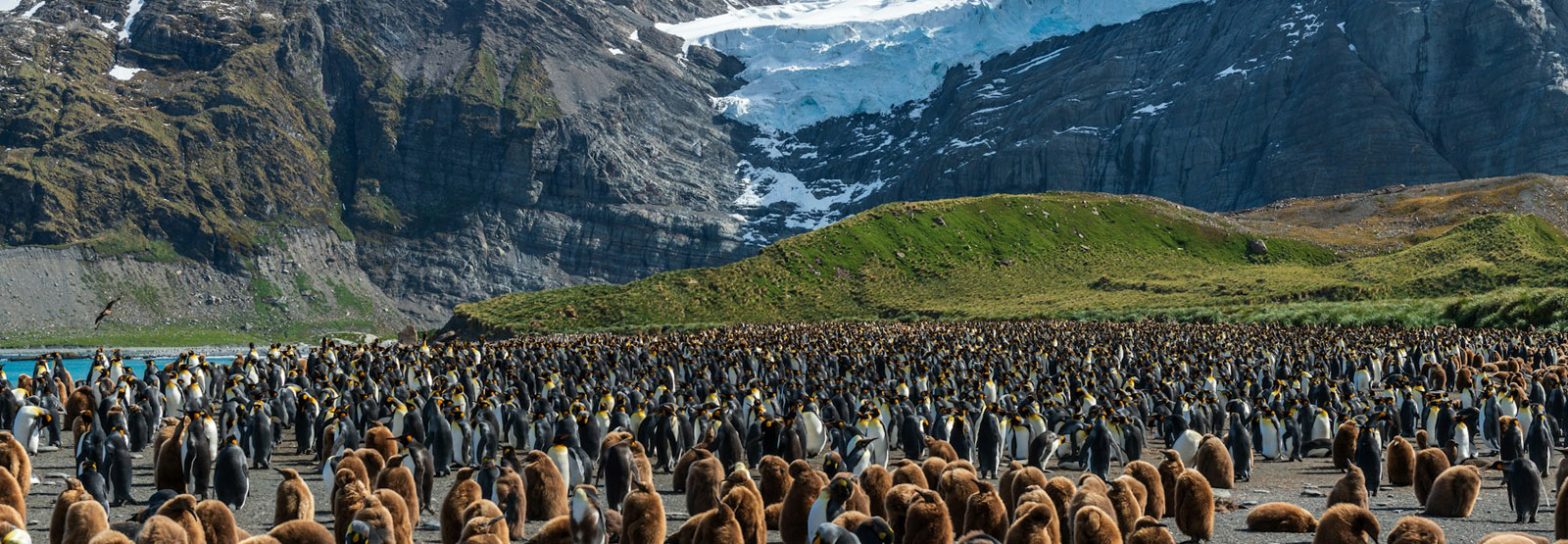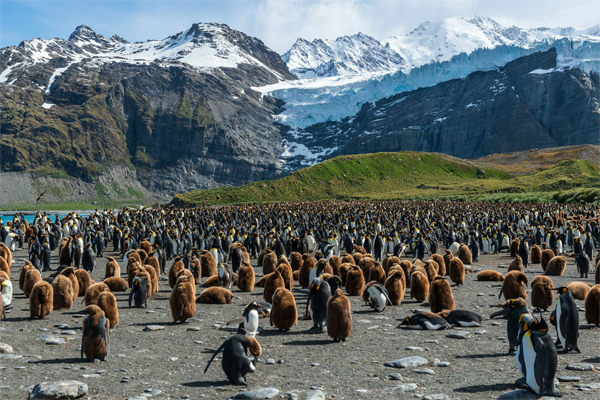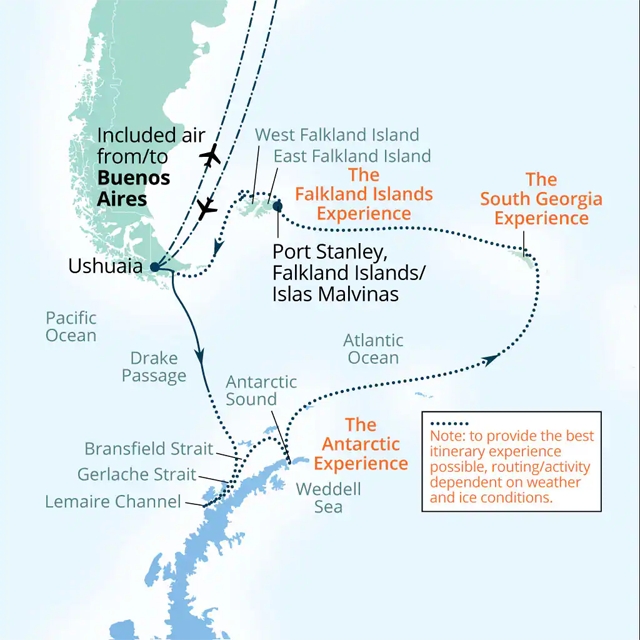DATES / RATES
Rates are listed per person
|
| Start Date | End Date | From EUR | From USD |
|---|
Rates are listed per person
|
| Start Date | End Date | From EUR | From USD |
|---|
ITINERARY
Day
0: ALVEAR ICON HOTEL (CHARTER)
Day
1: TRANSFER HOTEL/AIRPORT
Referred
to as the "Paris of South America", Buenos Aires is considered as one
of the most livable cities in South America. Although the bustling
capital city has just under 3,000,000 inhabitants and a population
density of 13,680 inhabitants per square kilometer (34,800 per square
mile), it was rated in 2018 as one of the top cities on the continent
for its ‘quality of life’. Twinned with world
cities such as Moscow and Miami, Buenos Aires displays through its
architecture, a cultural past rooted in both the Old and New Worlds. A
vibrancy for life can be seen everywhere. Crowded public markets,
street performers dancing the tango, colorful graffiti-style street
art, ultra-modern buildings, a dramatic skyline and a bustling port.
Culturally, Buenos Aires has the busiest live theatre industry on
Earth, outperforming New York, London and Paris. Every weekend, over
300 theatres are active with plays and productions.
Buenos
Aires was founded in 1580 by Spanish explorer Juan de Garay, and has
changed hands many times during its history.
BUENOS
AIRES AIR CHARTER TO USHUAIA
TRANSFER
AIRPORT/SHIP
For
centuries Ushuaia’s harsh climate seemed too forbidding for
the establishment of a European settlement, thereby leaving the land to
its native inhabitants, the Yahgan People.
Today,
however, Ushuaia is the southernmost city on Earth and is often
referred to as "the end of the world". Nestled on the banks of the
Beagle Channel, Ushuaia greets its visitors with a tapestry of colorful
houses dotted against a background of dramatic snow-capped mountains.
The jagged peaks of Monte Olivia, which tower some 4,530’
(1,318 m) above, dominate the landscape. Dense forests of Southern
beech trees, extend from sea level to alpine. Thanks to its
location and relative proximity to the Antarctic Peninsula, Ushuaia is
considered the gateway to the Great White Continent. Rich in natural
history, indigenous people’s heritage, and the spirit of
exploration, Ushuaia offers something for everyone, from spectacular
trekking in nearby Tierra del Fuego National Park to discovering the
rich stories and historical heritage at "The End of the World" museum.
Day
2: At Sea
Day
3: New Island, Falkland Islands
Wind-swept
New Island, one of the world’s most remote inhabited islands,
lies on the western fringe of the Falklands Archipelago. Its gentle,
low-lying eastern shores are indented with white, sandy bays and coves
beaming with turquoise water. Gradually rising, these slopes
are transformed into rugged sea-battered cliffs on the
island’s western side. A place of colorful landscapes, New
Island supports some of the largest concentrations and diversity of
wildlife in the Falklands, with over forty species of nesting birds.
Four species of penguins, including 13,000 gentoo and 26,000 Southern
rockhopper penguins call the island home. Embracing winds and seas
below, 60,000 black-browed albatross soar along the cliffs. New
Island’s history is as rich and plentiful as its natural
wonders. The island has known human presence since the late 1700s,
especially with many whaling ships finding refuge in its coves and bays
from tempestuous weather.
Day
3: West Point Island, Falkland Islands
Albatrosses
have long captured the imagination of sailors, roaming the vast oceans,
embracing storms and winds far from the safety of land and so at ease
in the roughest sea conditions. In summer, a large colony of
black-browed albatrosses come to breed on West Point Island. Along with
rockhopper penguins, they reside between the rocky ledges and among the
tussock grass. Other species can also be seen throughout the
island: fur seals and sea lions visit its shores and dolphins frequent
its harbor. Cliff Mountain, its highest point, rises to
1,250’ (381 meters) above the highest sea cliffs in the
Falklands. The Napier family, descendants of the original farmers,
still own and operate West Point Island as a traditional sheep farm.
Living in a modest family house sheltered by weathered Monterey cypress
trees, they welcome visitors in for a cup of tea. Experience West
Point’s spectacular scenery, abundant wildlife and its human
population of just two, Lily and Roddy Napier.
INCLUDED EXPEDITION:
Walks on shore and Exploration with the Expedition Team
Join the Expedition Team for a Zodiac landing on West Point Settlement.
A leisurely walk across the island will lead us to tussock-grass
covered area with cliffs, full of breeding seabirds. Majestic
Black-browed albatrosses, Rockhopper penguins and Blue-eyed cormorants.
Days
4: Carcass Island, Falkland Islands
Carcass
Island lies to the northwest of the Falklands. It is a wildlife haven,
as the island has been kept free of mice and rats. The
coastline of formed by large sandy bays, beaches, tidal rock point to
the north-west and cliffs and slopes along the north-eastern coast. The
islands has numerous bird species, including the endemic
Cobb’s wren, Gentoo & Magellanic penguins,
Ruddy headed geese and many more, freshwater ponds are important for
wildfowl. Commerson’s Dolphin frequently swim along the
coast. Over a hundred plant species form the green covering the island.
The name of the Island derives from 18th Century visitor, HMS Carcass.
INCLUDED EXPEDITION:
Walks on shore and Exploration with the Expedition Team
Join the Expedition Team for a zodiac landing on Carcass Island. Walk
around the settlement to enjoy first-hand views of the local
wildlife. The birdlife is particularly rich at Carcass, some
species expected to be found here are: Gentoo and Magellanic penguins,
Striated caracaras, Turkey vultures, Upland geese, Blackish
oystercatcher, Steamer ducks, Long-tailed meadowlark, Cobb’s
wren, and Falklands thrush.
Days
4: Saunders Island, Falkland Islands
Saunders
Island, a wild and remote jewel in the Falkland Islands, is steeped in
history. It was here, at Port Egmont, that the first British settlers
made their mark in 1765. Today, the spirit of these early pioneers
lives on, with descendants of the initial farming families still
residing on the island, carrying on the age-old tradition of sheep
farming.
But it's not just human history that makes Saunders Island so
fascinating—it's a veritable sanctuary for wildlife. The
island is home to five different species of penguin—king,
macaroni, gentoo, rockhopper, and the occasional
magellanic—each adding to the island's vibrant biodiversity.
In addition, 500 steamer ducks, white-bridled finches, and an
impressive 22,000 black-browed albatrosses choose to breed here. And if
you turn your gaze seaward, you might spot dolphins frolicking in the
harbor or Southern right whales in the distance.
Days
5: Stanley/Falkland Is/Islas Malvinas
The
lonely lighthouse at Cape Pembroke welcomes arrivals to Stanley. It
alerts ships to the treacherous rocks, reefs and shoals for which the
Falkland Islands have long been known. With a population of over 2,000
people, Stanley is the largest settlement on the islands. Its gardens,
tea rooms, brightly colored houses and hotels lend it a slightly
Victorian feel, seemingly suspended in time. The Anglican Cathedral,
the southernmost in the world, stands prominently on
Stanley’s waterfront.
The Falklands’ unique abundance of wildlife is evident in
Stanley. Dolphins visit its harbor, while steamer ducks, kelp gulls,
and other birds abound on shore. Southern sea lions can be spotted
basking in the sun. Southern giant petrels often fly through town,
oblivious to the human presence. Founded in the 1840s, the town was
named after Edward Smith-Stanley, Earl of Derby, who never visited the
islands.
INCLUDED SHORE EXCURSION:
Bluff Cove Lagoon: Penguins & Tea
Discover breeding King and Gentoo penguins and the abundant bird
species of the Falkland Islands on this scenic, off-road excursion to
the privately-owned Bluff Cove Lagoon wildlife haven. After tendering
ashore, you will be met by the Bluff Cove team and set out with your
driver/guide by minibus. A 20-minute journey takes you through Stanley
and across the rolling hills to Bluff Cove Farm. Here, switch to a 4x4
Land Rover vehicle. Your skillful driver will navigate the rugged
off-road terrain for 20 minutes to the Bluff Cove Lagoon penguin
rookery. A knowledgeable and friendly ranger will accompany you on a
leisurely stroll through the penguin colony, which features a scenic
backdrop of a large lagoon and a white, sandy beach that is
occasionally patrolled by sea lions from the nearby island. This
beautiful, pristine reserve is home to more than 1,000 breeding pairs
of Gentoo penguins which protect the growing colony of King penguins
and their chicks. Magellanic penguins, which burrow on the nearby
island, can often be found on the beach. Bird species that frequent or
nest in the area include skuas, upland geese, ruddy-headed geese,
Magellanic oyster-catchers, South American terns, dolphin gulls,
flightless Falkland steamer ducks, snowy sheathbills and southern giant
petrels, among others. At the legendary Sea Cabbage Café on
the beach, relax over tea, coffee and hot chocolate accompanied by
delicious home-baked treats such as scones with diddle-dee jam and
fresh cream. Bask in the warmth and aroma of the peat stove while the
enjoying splendid vistas of waves crashing on the sandy beach and
penguins porpoising in. The Bluff Cove Museum, also by the beach,
depicts life in the Falklands and tells the story of Bluff Cove. You
can find out about the farm, the nearby 1863 ‘sugar
wreck’, the 1982 war with Argentina and the fabulous lagoon
wildlife. You will have free time to take photographs, stroll along the
beach and look around the museum. A small gift shop sells unique Bluff
Cove souvenirs, including Bluff Cove tweed items made with the farm
wool, and postcards that can be stamped and mailed from here. Look for
samples of knitted, crocheted and felted local wool work displayed on
the walls of the café and museum.
OPTIONAL SHORE
EXCURSIONS: Kelp Point Exclusive Wildlife Excursion
Days
6-7: At Sea
Days
8-10: South Georgia Experience
The
South Georgia Islands Group is one of the least visited destinations on
earth. It consists of South Georgia Island and smaller surrounding
islands and rocks. Largely untouched and blessed with a sub-Antarctic
climate and nutrient-rich seas, it represents a sort of Lost Eden of
unspoiled wildlife habitat. Although ice and snow are present, they are
strikingly green with vegetation as compared with Antarctica. They teem
with wildlife, including massive populations of king and other penguin
species, fur seals, elephant seals, albatrosses, giant petrels, and
other seabirds. Whales, orcas and dolphins abound offshore in the most
diverse marine ecosystem on earth. Your captain and expedition leader
plan your days in South Georgia to offer you a variety of experiences
in this remote and enchanting destination, based on conditions and
wildlife reports. These will certainly include visits to historic
communities such as Grytviken, with its memorial to Ernest Shackleton,
the immense breeding colony of king penguins on the Salisbury Plain and
other highlights, along with less well-known, but equally unforgettable
sites. Your veteran expedition team members enrich your experience
during presentations and in casual conversations and interpret passing
sights during time spent cruising. They will also accompany you on
landings at the various sites and excursions in Zodiacs and kayaks.
The South Georgia Islands Group, is a gem in the heart of the
sub-Antarctic. Comprising of South Georgia Island and its smaller
surrounding islands and rocks, this untouched paradise houses a rich
tapestry of wildlife, thriving in a climate that is as harsh as it is
beautiful. Despite the presence of ice and snow, these islands are
remarkably green, their vegetation a stark contrast to the icy expanses
of Antarctica. This is a Lost Eden where nature reigns supreme, teeming
with an array of wildlife that includes vast colonies of king and other
penguin species, fur and elephant seals, albatrosses, giant petrels,
and other seabirds. Offshore, whales, orcas, and dolphins thrive in the
nutrient-rich waters, making this the most diverse marine ecosystem on
earth.
Your journey through the South Georgia Islands Group is carefully
curated by your captain and Expedition Leader based on local conditions
and wildlife reports. You'll venture to historic communities like
Grytviken, visit the sprawling breeding colony of king penguins on
Salisbury Plain, and explore the rarely-visited, lesser-known sites
nature allows.
Days
11-12: At Sea
Days
13-18: Antarctic Experience
Depending
on weather, ice conditions and reported wildlife distribution during
your voyage, your captain and expedition team will program an
additional day of discovery and adventure for you in Antarctica.
Days
19-20: At Sea
Day 21: Ushuaia, Argentina
USHUAIA
AIR CHARTER TO BUENOS AIRES TRANSFER CITY/AIRPORT TRANSFER SHIP/CITY
EZEIZA
INTERNATIONAL AIRPORT
TRANSFER
AIPORT/AIRPORT
 (Click image to view Ship details)
(Click image to view Ship details)
WHAT'S INCLUDED
Please Call Us to find out what is included in the fare
ADVENTURE
OPTIONS
- Exploring
Antarctica by Kayak - Starting at $295
- Diving
Antarctica by Submersible - Starting at $499
- Hiking
- Cultural
Tour
- Zodiac
Cruising







